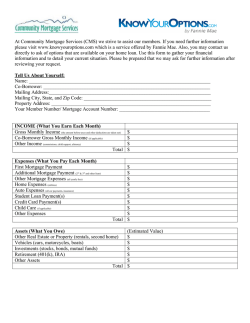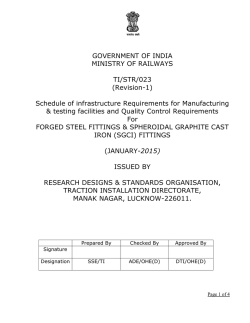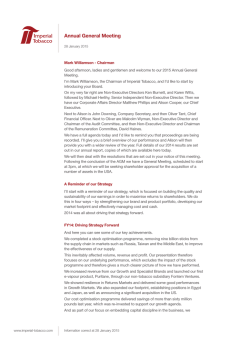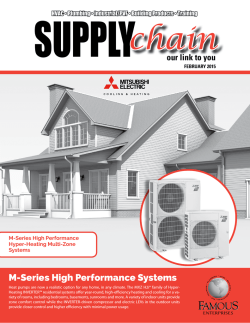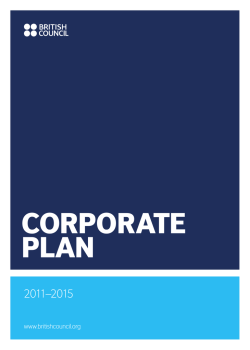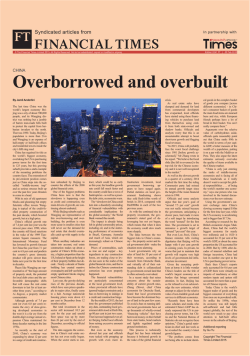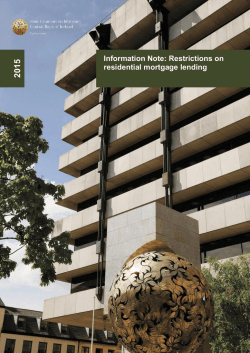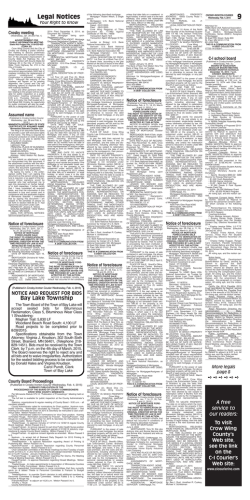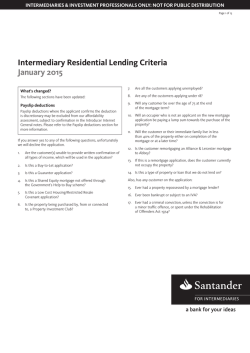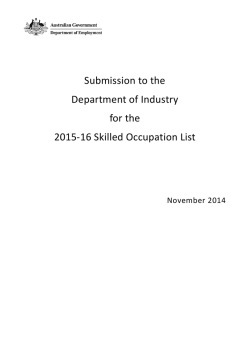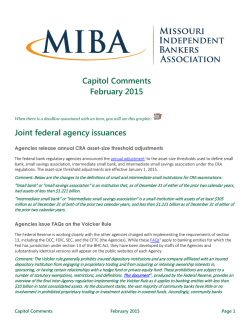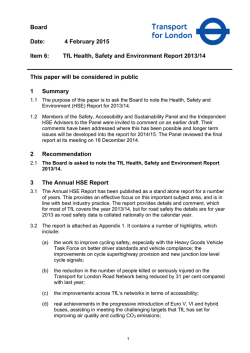
UPDATE
Jan/Feb 2015 real estate UPDATE Your Greater Toronto Real Estate Newsletter Market strength to continue No interest rate hikes soon I mproving labour markets will support stronger home sales in 2015. A report by Marcus & Millichap Research says up to 51,000 new jobs were created in the GTA last year. It says there will be job gains in professional/scientific/managerial services, financial/insurance/real estate services, retail/wholesale trade and construction. Broker Canada Mortgage and Housing Corp. (CMHC) believes that as the U.S. economy IN THIS improves, and with support from a weaker Canadian dollar, Ontario’s manufacturing indusISSUE BUY SMART. SELL SMART. tries will see improved employment prospects. Incomes are expected to increase modestly. In the GTA, fewer people are leaving the area to seek work out west. Immigration will 416-486-5588 What’s your [email protected] be higher than its historic average and will boost population growth and housing demand. stuff worth? HelgasHomes.com A new federal immigration program will make it easier for employers to find skilled Take a home inventory labour and qualified immigrants will be able to settle faster “and ultimately enter the homeownership market,” says CMHC. RE/MAX Hallmark Realty Ltd., Brokerage Perhaps most importantly, the federal housing agency says, “We do not expect Condo demand Independently Owned & Operated underestimated interest rate increases before the latter part of 2015 in both Canada and the United States. 723 Mt. Pleasant Road Prices edging up Inflation remains under control in both countries.” Toronto, ON M4S 2N4 CMHC’s forecast indicates that Toronto will set a new all-time record for home sales in 2015, when 96,000 transactions are expected. Mortgage? RRSP? TFSA? This year the federal housing agency predicts prices will rise by 2.2 per cent and in 2016 by another 1.8 per cent, when Where should you mortgage rate hikes are expected to start slowing down the market. CMHC also predicts that more listings on the market will begin invest? to put a drag on price growth, which will be good news for those who are saving up for a down payment. Overall, new listings in the GTA for all home types were down by 5.3 per cent in November compared to one year ago and active listings were down by 8.5 per cent. Average Home Prices - November in the Greater Toronto Area Figures from the Toronto Real Estate Board (TREB) show that in November, the $600,000 average price of a detached home in the City of Toronto was $935,122 – an increase of 9.4 $575,000 per cent compared to the same time period a year ago. In the 905 regions, the 2014 $550,000 average detached home price in November was $672,825, up 10.6 per cent from a year ago. $525,000 2013 Semi-detached home sales averaged $667,178 in the city and $449,429 in the 905 $500,000 regions during November. 2012 $475,000 2011 "The robust average price growth experienced throughout 2014 has been $450,000 fundamentally sound, with demand high relative to supply. Strong competition between $425,000 buyers has exerted upward pressure on selling prices,” says Jason Mercer, director of $400,000 6,908 5,613 6,354 6,519 market analysis for TREB. “Barring a substantial shift in the relationship between sales and Source: TREB Units Sold listings in the GTA, price growth is expected to continue through 2015.” REU 2 2 3 Monthly sales and average price by area November 2014 Central ..........1,231 East ...............1,514 North ............1,257 West..............2,517 October 2014 Central ..........1,550 East ...............1,919 North ............1,753 West..............3,330 September 2014 Central ..........1,409 East ...............1,840 North ............1,709 West..............3,093 August 2014 Central ..........1,260 East ...............1,761 North ............1,573 West..............3,006 July 2014 Central ..........1,533 East ...............2,058 North ............1,944 West..............3,663 June 2014 Central ..........1,721 East ...............2,278 North ............2,075 West..............4,106 May 2014 Central ..........1,816 East ...............2,549 North ............2,318 West..............4,396 April 2014 Central ..........1,644 East ...............2,185 North ............2,004 West..............3,873 March 2014 Central ..........1,325 East ...............1,843 North ............1,734 West..............3,179 February 2014 Central ..........1,059 East ...............1,216 North ............1,237 West..............2,219 January 2014 Central .............739 East ..................918 North ...............825 West..............1,653 December 2013 Central .............718 East ..................878 North ...............874 West...............1608 Source: TREB Home insurance $733,901 460,148 690,443 516,322 748,532 466,600 674,683 536,334 739,657 455,394 645,521 528,732 What's your stuff worth? Take a home inventory I nsurance is one of those topics that makes your eyelids heavy and your head start to nod...until something happens and you need to file a claim. If you had a fire or a break-in at your home, would you be able to tell your insurance company exactly what possessions you lost and what they are worth? Most homeowner’s policies cover contents up to a specific percentage of the total insured value of the home, 671,600 425,484 659,435 505,363 656,226 444,098 641,569 518,203 726,072 451,298 645,320 546,350 787,515 454,005 657,169 539,758 767,648 449,713 640,098 537,486 711,051 436,411 643,200 517,423 708,437 424,716 629,132 507,176 669,711 414,833 614,906 480,436 640,823 416,447 605,424 477,171 according to the Insurance Bureau of Canada (IBC). You can also buy extra insurance for more valuable items. The IBC and several insurance companies offer online home inventory lists. You can fill out these inventories online or print out the list and do it by hand, and then store the completed inventory in a safety deposit box or a fireproof safe. The list should include everything that’s in each room, including its cost, purchase date, and serial number (if it has one). Take pictures or video of all of your valuables, including electronics, jewellery, artwork and other prized possessions, and keep the photographic record with your inventory list. Every time you make a major purchase, keep the original sales receipt, along with the owner’s manual if there is one. These items can serve as proof of ownership. It is a good idea to update the list annually to reflect new purchases or items that you’ve replaced. For more information about home insurance, visit www.ibc.ca REU Condo update Condo demand underestimated Prices edging up A recent report from CIBC World Markets reveals that official population projections may be underestimating population growth by almost 100,000 people, which has big implications on housing demand. The report found that new immigrants account for about 70 per cent of the increase in the Canadian population. Many of them settle in the GTA. Half of them are in the “prime-aged, 25 to 44-year-old cohort [which] represent the economy’s engine as those who have the highest employment levels and those most likely to start families.” They are also prime home buyers. The authors, Banjamin Tal and Nick Exarhos, discovered that the number of non-permanent Canadian residents including students, temporary workers, and humanitarian refugees - increased by 22,000 to 774,000 in 2013. “Those are big numbers,” say the authors. “When it comes to measuring household formation in Canada and its implication for the appropriate level of homebuilding, we systematically understate the number of those non-permanent residents.” More households translates into more condo buyers and more renters for condo investors. During the month of November 2014, the average condo apartment in the City of Toronto sold for $394,225, an increase of 2.0 per cent compared to the same time in 2013. In the 905 regions, the average condo apartment sold for $310,220, an increase of 11.8 per cent compared to a year ago. Furthermore, CMHC predicts that demand for condo apartments from both baby boomers and millennials will continue to increase during the next two years. REU On the internet Money matters Mortgage? RRSP? TFSA? Where should you invest? F or years we have wondered if it was better to pay off the mortgage or contribute to a Registered Retirement Savings Plan (RRSP). And to add to our choices the government introduced another option: the Tax-Free Savings Account (TFSA). ”Perhaps no question has been discussed more in the annals of personal finance than whether, given a fixed amount of annual income, we should use those funds to save towards retirement or to pay down debt,” says Jamie Golombek of CIBC Private Wealth. Mortgage interest rates have remained at historically low levels for several years and shouldn’t rise for at least a year, so it’s tempting to hang on to the mortgage and invest elsewhere. However, if rates climb near or at your mortgage renewal time, you may regret not paying down the debt faster. “When tax rates today are the same as the tax rates that are expected to apply on further plan withdrawals, the decision…boils down to a mathematical question: Can you get a higher rate of return on your investments than the interest rate on your debt, given a level of risk at which you are comfortable?” says Golombek. “If so, then investing is the better bet; otherwise, paying debt is the better choice.” A big consideration when making this decision is your tax situation. RRSPs are taxable upon retirement. If you have a company pension plan that will provide secure income and you add your RRSP income to it, you could find yourself in a higher tax bracket. Some of your Old Age Security benefits could be clawed back by the government. In this case, it’s better to pay off the mortgage or invest in a TFSA, neither of Interesting websites interiordesignshow.com This event showcases the newest trends, products and ideas driving design today. Promises to delight with world-renowned designers and architects as keynote speakers. Jan 22-25 kids.nationalgeographic.com National Geographic Kids is a fascinating site that appeals to young net surfers. They will have lots of fun and learn too. thefamilycaregiver.com A useful resource for aging and long-term care planning that helps caregivers meets the challenges of aging and elderly care. canadianwellness.com A comprehensive directory of fitness, diet, health, nutrition and other wellness-related professionals and their services. which has tax implications. You can only invest up to $5,500 in a TFSA each year and there are tax penalties if you go over that amount. You may invest up to 18 per cent of the previous year’s income in an RRSP. The amount you can pay off your mortgage depends on the terms of your contract. REU These sites are believed to be reliable but their accuracy cannot be guaranteed. Mortgages 2014 Rates Mortgage rates are negotiable with individual lenders. Check to be sure that you are getting today’s best possible rate. At December 5, 2014 6-month . . . . . . . . . 4.00% 1-year . . . . . . . . . . . 3.00% 2-year . . . . . . . . . . . 3.04% 3-year . . . . . . . . . . . 3.04% 4-year . . . . . . . . . . . 3.09% 5-year . . . . . . . . . . . 3.09% Prime rate . . . . . . . . 3.00% Furnaces GTA ’14 totals Heating your home this winter F urnaces aren’t known for being fickle, but there are certain protective measures homeowners should implement to ensure their homes are warm and comfortable this winter. to form on cool surfaces, like windows. Homeowners can reduce condensation and the risk of mold by lowering the interior humidity level. The recommended house humidity levels are: Outside Recommended House Temperature Humidity -20°F (-28°C) 15% -20 °F to -10°F (-28 to -23°C) 20% -10 ° F to 0°F (-23°C to -18°C) 25% 0°F to +10°F (-18°C to -12°C) 35% 10+° F (above -12°C) 40% Summer months Off Furnace Filters Your furnace filter should be checked monthly to determine if it needs cleaning or changing. Typically located in the air return duct adjacent to the furnace, making sure your furnace filter is in good condition can help improve both comfort and heating costs. You will need to see if you should purchase a cleanable or disposable furnace filter – most homeowners choose to have a disposable filter, for convenience, but both are good choices. Watching for condensation on your windows is another great Furnace Humidifiers way to gauge your house humidity level. Lower the humidity While ideal humidity for homes can be as low as 5%, people when you see condensation. In addition, room temperature and feel the most comfortable in environments with 60% humidity. humidity monitors, available at hardware and building supply Unfortunately, houses can have a hard time coping with this stores, can help you manage your humidity. in cold weather. Too little humidity makes people feel uncomfortable. Too much can cause condensation, mold, Furnace Efficiency mildew, and rot in homes as the warm moist air hits cool High efficiency furnaces are complex, and as a result they’re surfaces. Contrary to popular belief, homeowners actually have often more expensive than conventional furnaces. High to lower the humidistat setting as the weather outside gets efficiency furnaces on average cost about $1,000 – $1,500 more colder. The colder it is outside, the easier it is for condensation than a conventional furnace. If you spend $1,000 per year Referrals are an important part of my business. Anyone you refer will receive special attention and the finest service possible. For professional Broker real estate advice please call, any time. Thank you! 416-486-5588 heating your house with a conventional furnace, you can save close to $350 with a high efficiency furnace. A high efficiency furnace may pay for itself in 3 years. If you’re considering a high efficiency furnace for your home, speak with a reliable heating or HVAC contractor to discuss the pros and cons of various models and any estimated increase in Sales activity of single-family homes Most recent month, year to date Active listings November ...........14,717 YTD ..........................N/A New listings November.............8,789 YTD....................151,535 Sales November.............6,519 YTD......................88,462 Average price November .......$577,936 YTD ..................$567,198 Median price November .......$477,000 YTD ..................$475,000 Average days on market November .................27 YTD............................24 Average percentage of list price November .................99 YTD............................99 Source: TREB Housing market indicators Single-family dwellings furnace maintenance costs. The above article is reprinted with the permission of Carson, Dunlop & Associates Ltd., Consulting Engineers – Expert Home Inspections. The intent of this newsletter is to inform you regarding real estate. Your personal details such as name and address are never shared without your consent. In accordance with the new Privacy Act, your consent must be given (either explicitly or implicitly) to receive the newsletter. If you do not wish to receive this newsletter, please notify me. This publication is not intended to solicit buyers or sellers currently under contract with a brokerage. The information and opinions contained in this newsletter are obtained from various sources believed to be reliable, but their accuracy cannot be guaranteed. The publishers assume no responsibility for errors or omissions or for damages resulting from using the published information and opinions. This newsletter is provided with the understanding that it does not render legal, accounting or other professional advice. Whole or partial reproduction is forbid den without written permission from the publisher. © Clear Communications 416-422-5754. Source: TREB Sales New Listings Nov ‘13 Nov ‘14 % Change 6,354 6,519 2.6% 9,281 8,789 - 5.3%
© Copyright 2026
